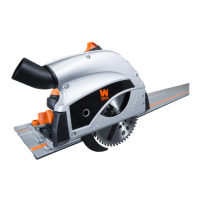4
15. DO NOT OVERREACH. Keep proper footing and balance at all times. Wear oil-resistant rubber-soled foot-
wear. Keep the floor clear of oil, scrap, and other debris.
16. MAINTAIN TOOLS PROPERLY. ALWAYS keep tools clean and in good working order. Follow instruc-
tions for lubricating and changing accessories.
17. CHECK FOR DAMAGED PARTS. Check for alignment of moving parts, jamming, breakage, improper
mounting, or any other conditions that may affect the tool’s operation. Any part that is damaged should be properly
repaired or replaced before use.
18. MAKE THE WORKSHOP CHILDPROOF. Use padlocks and master switches and ALWAYS remove start-
er keys.
19. DO NOT operate the tool if you are under the influence of drugs, alcohol, or medication that may affect your
ability to properly use the tool.
20. USE SAFETY GOGGLES AT ALL TIMES that comply with ANSI Z87.1. Normal safety glasses only have
impact resistant lenses and are not designed for safety. Wear a face or dust mask when working in a dusty environ-
ment. Use ear protection such as plugs or muffs during extended periods of operation.
GENERAL SAFETY RULES
WARNING: Do not let comfort or familiarity with product (gained from repeated use) replace strict
adherence to product safety rules. If you use this tool unsafe or incorrectly, you can suffer serious per-
sonal injury!
1. Hold the tool by insulated gripping surfaces when performing an operation where the tool may contact hidden
wiring. Contact with a “live” wire will make exposed metal parts of the tool “live” and shock the operator.
2. DANGER! Keep hands away from the cutting area and the blade. Keep your second hand on the auxiliary handle
or motor housing. If both hands are holding the saw handles, they cannot be cut by the blade. Keep your body po-
sitioned to either side of the saw blade, but not in line with the saw blade. KICKBACK could cause the saw to jump
backwards. Do not reach underneath the workpiece. The guard cannot protect you from the blade protruding from
the underside of the workpiece. Do not attempt to remove cut material when the blade is moving.
CAUTION: Blades coast after turning the saw off. Wait until the blade stops before reaching for loose material.
3. Always make sure the saw blades are sharp, undamaged and tightly attached before each use. Only use blades that
meet all the specifications of this particular model of saw. Do not use blades with incorrect diameters or mismatched
arbor holes. They will not rotate correctly and may damage the saw or injure the user.
4. Make sure the riving knife is thicker than the saw blade and thinner than the blade teeth. The riving knife must
be present in the kerf and properly adjusted with the blade in order to maximize effectiveness.
5. Make sure that all guards are in proper place and working condition before each cut. Do not operate if broken.
6. Always observe that the blade has properly retracted before placing the saw down on a bench or floor. An unpro-
tected, coasting blade will cause the saw to walk backwards, cutting whatever is in its path.
SPECIFIC RULES FOR TRACK SAWS

